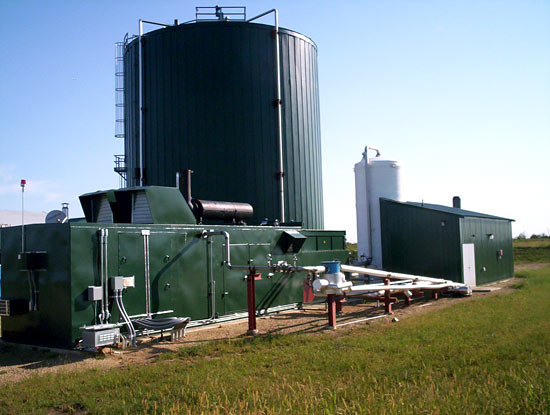 [Image: Photo via Reuters].
[Image: Photo via Reuters].You've no doubt seen this elsewhere by now in our internet-flattened world, but this geometrized pool of cow manure will "provide the natural gas needed to power 1,200 homes a day."
- To tap the renewable gas from cow manure, the Vintage Dairy farm first flushes manure into a large, octagonal pit, where it becomes about 99 percent water. It is then pumped into a covered lagoon, first passing through a screen that filters out large solids that eventually become the cows' bedding.
The covered lagoon, or "digester," is the size of nearly five football fields and about 33 feet deep. It is lined with plastic to protect the ground water and the cover, made of high density polyethylene, is held down at the edges by concrete.
As one of the companies involved, BioEnergy Solutions, explains it: "We capture the methane released as livestock waste decomposes, then 'scrub' it to create clean, renewable natural gas that is delivered to power plants. The process can reduce methane emissions by up to 70%, or an estimated 1,500 tons per year, on a 5,000-cow dairy farm."
 [Image: Photo courtesy of American Images, Marshfield, WI, via CNET News].
[Image: Photo courtesy of American Images, Marshfield, WI, via CNET News].Of course, news like this has been coming out for years now – for instance, in this story about Californian farmer Albert Straus and his "poop-filled lagoon":
- In addition to the energy savings, Straus' new methane digester [the "lagoon"] will eliminate tons of naturally occurring greenhouse gases and strip 80 to 99 percent of organic pollutants from the wastewater generated from his family's 63-year-old dairy farm. Heat from the generator warms thousands of gallons of water that may be used to clean farm facilities and to heat the manure lagoon. And wastewater left over after the methane is extracted, greatly deodorized, is used for fertilizing the farm's fields.
In any case, I'm wondering what effects the cow poo boom will have on civic infrastructure – and even if human sewage might someday be tapped for its decompositional energy potential.
What strange new world of plumbing awaits us on the alternative energy horizon? How might it reshape the urban landscape?
(Thanks, Michael G.!)
No comments:
Post a Comment